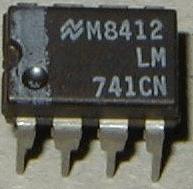As player easy to carry, easy to operate, better sound quality and therefore were in favor of the school Philharmonic. However, players have adopted a low DC power supply (such as 1.5 V, 2V, 3V), the output power of small. I designed a special power output up to 1 W simple small amplifier, such as a loudness, noise reduction, volume and tone control, and other functions, and low cost, only 30 yuan. Its circuit schematics see at top.

Search... ELectronics :
Practical small amp
Changing between AC and DC coupling
AC coupling means that only the AC parts of the signal will pass. For this normally a capacitor is used that connects the two circuits. The minimum value of the capacitor depends upon the lowest frequency (f) that has to be transmitted and the input/output impedance (R) of the two circuits. The approximate formula for the minimum capacity is C ~ 1/(R*f) with f = lowest frequency, R = in/output resistance Example: minimum frequency = 50Hz, in/output resistance = 10kOhm -> C ~ 2 uF (u = micro = 1/1000000). A usual value would be 2.2uF in this example. AC coupling is normally used for audio signals. For audio signals AC coupling has the advantage that unwanted DC shares in the signal are removed. For some AC processing circuits (e.g. amplifiers, filters) DC voltages are not allowed in the input signal. Therefore very often a capacitor can be found in the input stage of such circuits. DC coupling means that both DC and AC parts of a signal are transmitted. For control voltages (normally) only DC coupling can be used as even fixed voltages (e.g. coming from a manual control) have to be transmitted. In a module patch each A-100 module can be treated as an electronic circuit that is connected to another one. Consequently one has to take into consideration the type of coupling (AC or DC) between modules as the strict differentiation between AC and DC applications os softened for some A-100 modules. E.g. a VCA can be used to process audio signals (i.e. normally AC coupled signals) as well as slowly changing CV voltages (e.g. envelope or modulation amount). Therefore one needs to know if a VCA used is AC or DC coupled. Another example is a divider (e.g. A-115 or A-163) as even these module can be used to process audio or (slow) clock/gate signals. Luckily it is not very complicated to switch between AC and DC coupling. All one has to do is to bride (i.e. short circuit) the capacitor in case of an AC coupled in/output. The left picture shows how the switch is connected in parallel to the AC coupling capacitor (the broken line resistor symbol represents the load to GND that is always available in each circuit as reference to GND). If AC coupling is required for a DC coupled in/output simply a capacitor has to be added. From the schematics it can be seen if an in/output is AC or DC coupled. We will add this information also to the user's manual for modules that may be used for both types of coupling. For some circuits resp. modules changing from AC to DC coupling is not possible. E.g. the "old" VCAs A-130 and A-131 (those with CEM3381 or CEM3382) are AC coupled as the special CEM circuits cannot be DC coupled because of the internal negative reference voltage. The "new" VCAs A-130 and A-131 (those with CA3080) are DC coupled and can be used to process CV signals too. A list with the type of coupling for all modules in question will follow soon. For most of the modules the question about the type of coupling does not arise. E.g. all filters are AC coupled and all CV generating and processing modules (e.g. ADSR, LFO, slew limiter, Theremin, Ribbon controller, random voltage) are DC coupled. But for other modules the type of coupling is not obvious (e.g. VCA, divider, waveshaper).There are two types of coupling between electronic circuits: 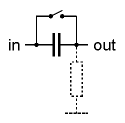
Changing the sensitivity of manual controls, control voltage inputs and audio inputs
P1 is the manual control of the corresponding parameter (e.g. tune for a VCO, frequency for a VCF, manual gain for a VCA, manual phase shift for a phaser and so on). P1 generates the voltage U1. R3/R1 * U1 + R3/R2 * U2 The relations R3/R1 resp. R3/R2 determine the sensitivity of the corresponding control (P1) resp. input (J1/P2). If for example all resistors are 47k (a common value in the A-100) the sensitivity is 1 for each input. Provided that R3 remains unchanged the resistors R1 and R2 determine the sensitivity of the corresponding control resp. input. Reducing the resistance of R1 resp. R2 increases the sensitivity of the manual control (P1) resp. input (J1/P2). Increasing the resistance of R1 resp. R2 reduces the sensitivity. To modify the sensitivity of a control knob (P1) or CV input (J1/P2) the corresponding resistor R1 resp. R2 simply has to be changed. Even the input resistors of CV or audio mixers (e.g. A-138a/b) can be changed to allow "real" amplification (i.e. > 1). The factory values of the resistors in the mixer modules A-138a/b allow a maximum amplification of about 1 (which is not really amplification). Reducing the input resistors (R2 type) or increasing the feedback resistor (R3 type) will increase the amplification of the circuit. The factory values of the corresponding resistors (R1, R2, R3) for all modules can be found in the A-100 service manual. Normally they are in the 100k range (~ 47k...220k).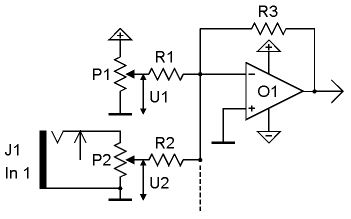
J1 is the (first) input socket for the external control voltage. P2 is the corresponding attenuator. The slider of P2 outputs the voltage U2. Additional CV inputs with our without attenuators may be available (e.g. two or more CV inputs for frequency control for a VCF). The dashed line in the picture is the common point in the circuit where all CV's are added.
The output voltage of the circuit (output of O1) is used to control the corresponding parameter (tune, filter frequency, gain ...) of the module in question. The output voltage is defined by:
Changing the resistance of R3 has the opposite effect and affects the sensivity of both the manual control and CV input.The audio input circuit for most A-100 modules is similar but the manual control P1 is absent (a DC offset would not make sense for an audio input, audio signals are AC signals). Normally only one audio input is available but there are exceptions (e.g. VCA A-130 and A-131, signal processor A-109). To change the sensitivity of an audio input simply the resistor R2 connected to the slider P2 of the audio input has to be replace. A smaller value will increase the sensitivity and consequently lead to clipping/distortion for higher input levels. Especially for the first A-100 VCFs and VCAs (A-120, A-121, A-122 and first versions of A-130, A-131) the audio inputs have been designed to avoid distortion with standard A-100 signals (e.g. VCO). Lowering the input resistors will allow distortion for these moduls too.
Circuit examples
Mixer with optional offset function and inverted/non-inverted outputs Inputs J1 ... J3 are standard inputs. At J5 the inverting sum of all inputs is available. J6 outputs the non-inverting sum. P5 allows an additional attenuation of the complete signal (affects only J6). Typical values for the parts used: The value of R8 defines the offset range (about 0...+6V for R8=33k, a lower value of R8 will increase the offset range and vice versa). Matrix Mixer Matrix Mixer The CV mixer described above can be expanded to a so-called matrix mixer. This circuit has several inputs available (three in the example circuit) that can be mixed to different outputs (three in the example circuit) with adjustable levels. At each point of the matrix a potentiometer is available that defines the level for the matrix junction in question. The circuit can be used for CV or audio applications. The number of inputs and outputs can be increased to the desired value of columns and rows. For each of the outputs the two OpAmp circuit with the corresponding output socket is required. For each input another socket and the corresponding quantity of potentiometers and resistors is required. Typical values for the parts used: To obtain a higher or smaller overall amplification the feedback resistor of the first (left) OpAmp of each output circuits has to be adjusted (as described above). It is recommended to use a separate pcb for the output circuits. The input sockets and matrix potentiometers/ resistors can be wired by hand very easily. Manual Gate Manual Gate The left picture shows the basic circuit of a manual gate. The 470 Ohm resistor serves as a short circuit protector. Without this resistor the +12V supply would be shorted to GND if a patch cable is inserted to the socket while the button is pressed. The right picture is expanded by a LED display that lights up while the button is pressed. Or-wired sockets Or-wired sockets The left picture shows the circuit of "or-wired" sockets. This circuit is useful to combine gate or trigger signals. The incoming signals are or-wired, i.e. if any of the inputs is "high" the output turns "high" too ("high" means a positive voltage in the range of typical +5...+12V). If none of the inputs is high the 10k pull-down resistor pulls the output to GND, i.e. "low". For most applications this resistor is not required as the input load of the following module acts as pull-down resistor. But it should be added to be on the safe side. As a modification of this circuit even "and-wired" sockets can be realized. But this type of combination is not used very often: all inputs have to be "high" to turn the output to "high". For all other conditions the output remains "low". On this the diodes have to be flipped (i.e. the cathodes at connected to the input sockets) and the resistor has to be connected between the output and +12V (so-called pull-up resistor). In addition the switching contacts of the input sockets have to be connected to GND (normalled to GND). This measure is necessary in order that unused sockets read "low". Otherwise unused sockets would read "high" because of the pull-up resistor. For example a multiple A-180 can be modified with 7 additional diodes and one resistor to obtain seven or-wired sockets and one output socket. For this the pcb tracks between the eight multiple sockets have to be interrupted (not the GND connections, only the "hot" connections) and re-wired with the diodes and the resistor. Non-inverting power amplifier This is a simple non-inverting power amplifier that can be used to drive loads like light bulbs, LED bars, fairy lights, motors, magnets, relays or other loads. Pay attention that the connected load is suitable for 12V supply voltage. Otherwise the supply voltages of the operational amplifier and the power transistors have to be adapted. If only positive output voltages are required Q2 can be omitted. If an operational amplifier is available in the preceding module (e.g. a mixer A-138) this operational amplifier can be used and only Q1, Q2 and R3 have to be added. The maximum output current depends upon the specifications of the power transistors. Pay attention that the power supply has to be able to deliver the additional load current ! For higher currents (~ beyond 100mA) the transistors have to be mounted on suitable heat sinks. Attention: The output is not short circuit protected. If a standard A-100 jack socket is used the output connection has to be established before power is turned on ! During the insertion of a plug into the jack socket a short circuit is made for a short time. Therefore another type of socket is recommended for the output (not the jack socket shown in the picture). 
Input J4 has offset function provided that no plug is inserted into J4 as the switching contact of J4 is connected to the positive supply voltage in this case (via the protection resistor R8).
O1, O2 = LM1458, TL082, NE5532
P1...P4 = 47k linear (CV) or log (audio)
R1...R7 = 100k (for overall amplification 1)
To obtain a higher overall amplification R5 has to be increased (e.g. to 220k for overall amplification ~ 2 or to 1M for overall amplification ~ 10).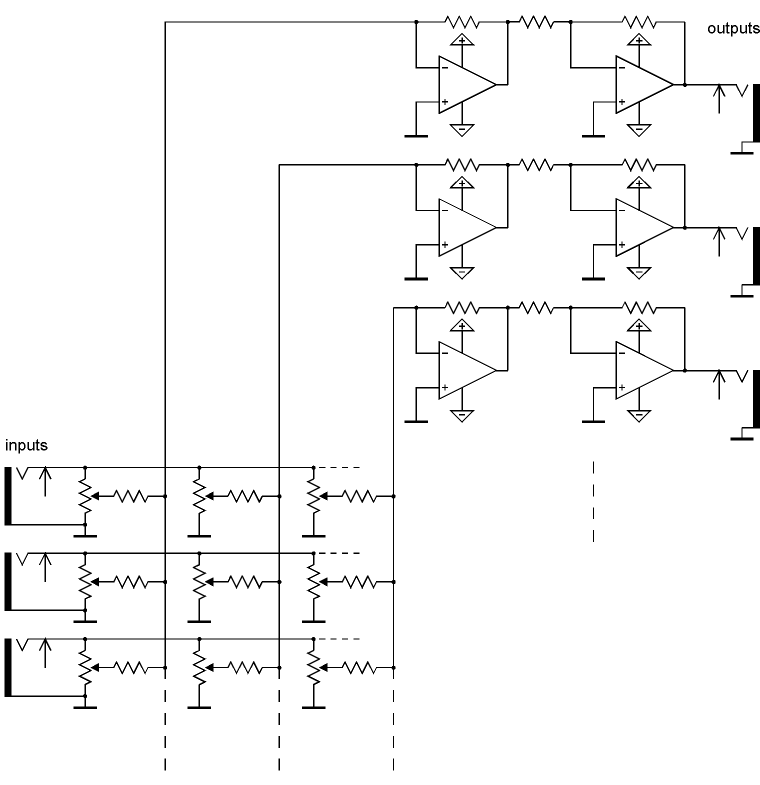
All operational amplifiers: LM1458, TL082, NE5532
All potentiometers: 47k linear (CV) or log (audio)
All resistors: 100k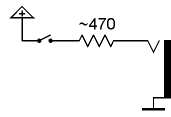

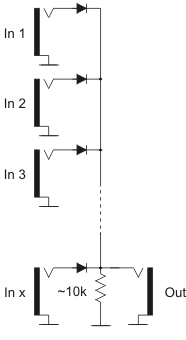
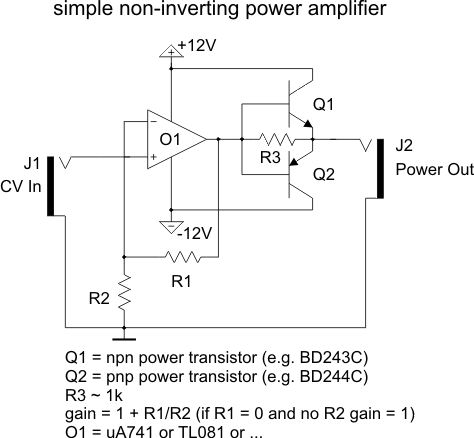
Basic circuits
Simple attenuator This is a simple passive attenuator (i.e. no power supply required). J1 is the input socket, J2 the output socket. A typical value for P2 is 10k...100k. A linear or logarithmic type can be used for P2 (logarithmic especially for audio applications as the loudness characteristics of the human ear is approx. logarithmic). Simple lowpass This is a simple passive lowpass with 6dB/octave slope. A non-inverting amplifier can be added at the output (and even at the input) to make the circuit independent of input/output impedance (i.e. the "loads" connected to J1 resp. J2). Replacing of R1 by a vactrol leads to simple voltage controlled lowpass filter. Replacing R1 by a potentiometer leads to a simple manually controlled lowpass filter Frequency of the lowpass: f = 1/(2 * Pi * R1 * C1) with Pi = 3.14 Simple highpass This is a simple passive highpass with 6dB/octave slope. A non-inverting amplifier can be added at the output (and even at the input) to make the circuit independent of input/output impedance (i.e. the "loads" connected to J1 resp. J2). Replacing of R1 by a vactrol leads to simple voltage controlled highpass filter. Replacing R1 by a potentiometer leads to a simple manually controlled highpass filter Frequency of the highpass: f = 1/(2 * Pi * R1 * C1) with Pi = 3.14 Non-inverting amplifier This is a simple non-inverting amplifier: The term "non inverting" means that the polarity of input and output signal are the same. In other words: a positive input signal applied to J1 will cause a positive output signal at J2 and a negative input signal applied to J1 will cause a negative output signal at J2. The amplification of this circuit is 1 + R1/R2. If R1 or R2 is replaced by a potentiometer the amplification can be adjusted. If e.g. R1 in the last example is replaced by a 100k potentiometer the amplification is adjustable in the range 1...11. This circuit can be used to built an simple amplifier if the desired audio or CV signal is too small for a certain application. Attention ! The minimum amplification of this circuit is 1 (no real attenuation possible provided that no external attenuator is used). Inverting amplifier This is a simple inverting amplifier: The term "inverting" means that the polarity of input and output signal are opposite. In other words: a positive input signal applied to J1 will cause a negative output signal at J2 and a negative input signal applied to J1 will cause a positive output signal at J2. The amplification of this circuit is - R2/R1 (" - " indicates the opposite polarity of input and output) The minimum amplification of this circuit is zero (if R2 = 0). To obtain a non-inverted output another inverting amplifier with amplification - 1 has to be used. The inverting amplifier can be extended by adding more input sockets (J1) and corresponding input resistors (R1). The right terminals of all input resistors are connected to the inverting input (-) of the operational amplifier O1. The relation between the corresponding input resistor R1 and R2 (the same for all inputs) defines the sensitivity of the input in question. If all resistors have the same value (e.g. 100 kOhm) the amplification is "1" for all inputs. Lowering R1 (e.g. 47k or 22k) increases the sensitivity of the input in question. Increasing R2 (e.g. 220k or 1M) increases the amplification resp. sensitivity for all inputs simultaneously. The first circuit example (chapter 3: "CV mixer with offset function") shows a typical application of inverting amplifiers with several inputs.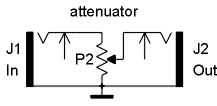

Example: R1 = 47kOhm, C1 = 10nF -> f ~ 340 Hz 
Example: R1 = 10k, C1 = 2,2n -> f ~ 7.2 kHz 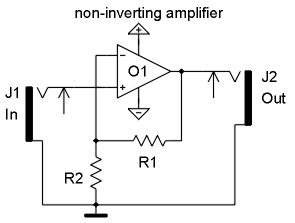
Example 1: R1 = 0 Ohm (connection), R2 omitted -> A = 1
Example 2: R1 = 47k, R2 = 47k -> A = 2
Example 3: R1 = 100k, R2 = 10k -> A = 11 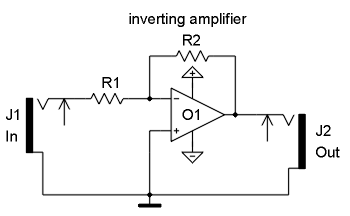
Example 1: R1 = R2 = 47k -> A = - 1
Example 2: R1 = 10k, R2 = 100k -> A = - 10
If R2 is replaced by a potentiometer the amplification can be adjusted. If e.g. R2 in the last example is replaced by a 100k potentiometer the amplification is adjustable in the range 0...-10. This circuit can be used to built an simple (inverting !) amplifier if the desired audio or CV signal is too small for a certain application.
The minus terminal of the operational amplifier is often called "virtual GND" in this circuit as the voltage measured at this point is very close to GND within a few millivolts - independent of the incoming voltages!
Electronic Parts
(For some parts different signs are shown. Normally the left one is used in USA or Japan, the right one in Germany or Europe) Fixed resistors A resistor is determinded by these parameters: value (... Ohm, ... kOhm, ... MOhm, usual abbreviations kOhm = k and MOhm =M, e.g. 2.2 kOhm = 2.2k or 2k2) power (.. mW, ...W) tolerance (%) max. voltage dimensions (e.g. length, diameter and especially the grid between the legs on the pc board) In the A-100 normally only resistors with 1/4W (250mW) and 5%, 1% or 0.1% tolerance are used. For the value and tolerance of a resistor normally a color code is used (should we add the color code at this place ?). Potentiometers Potentiometers are available as rotary potentiometers or fader types. Normally, a potentiometer has 3 terminals: two end terminals and a slider terminal (upper picture). The slider touches a resistance surface that is located between the end terminals. Sometimes the second end terminal is not shown (lower picture) if only one end terminal is required, e.g. if the part works only as a variable resistor rather than a voltage divider. A potentiometer is determined by these parameters: value (... Ohm, ... kOhm, ... MOhm) power (.. mW, ...W) tolerance (%) characteristics (law) mechanical dimensions (e.g. diameter, type, length and material of the axis, distance and diameter of the holes required on the pc board, position of auxiliary terminals without electronic function and so on) The characteristics - sometimes even called law - is a very important parameter of a potentiometer. This parameter describes the connection between the rotary angle (resp. fader position for fader potentiometers) and the resistance value between terminal 1 and slider terminal. Typical characteristics are linear, logarithmic and inverse logarithmic. Sometimes special characteristics are used (e.g. S-type law) but these are not very common. For audio attenuation normally logarithmic potentiometers are used as the human ear senses the loudness of an audio signal in a logarithmic way too. The same applies to potentiometers that are used to control time parameters (e.g. attack/decay/release time of an envelope generator). For attenuation of control signals normally linear potentiometers are used. For special functions inverse logarithmic potentiometers are used (e.g. resonance/emphasis control in filter circuits). A very special circuit is a so-called vactrol. This is a combination of a light depending resistor (LDR) and LED both put into a small 100% light-proof case. For details please refer to the vactrol document. The above pictures shows the type of potentiometers used in the A-100 system. These potentiometers are equipped with a mounting bracket that increases the mechanical stability. For most of the A-100 modules the potentiometers (together with the sockets) are used to mount the pc boards to the front panels. Trimming potentiometers The electronic function of a "normal" potentiometer and a trimming potentiometer is the same. The only difference is the mechanical appearance: trimming potentiometers are normally much smaller and have a very short axis that is adjusted with a screw driver. Trimming potentiometers are used to adjust parameters that have to bet set once at the factory and that are normally not controlled by the user (e.g. offset frequency and scale of a VCO, maximum/minimum limitation of values, adjustment of click/pop feedthrough of sound processing devices like VCA, VCF, ring modulator, frequency shifters and so on). Sometimes users replace trimming potentiometers with normal ones to have access to such additional parameters. Capacitors A capacitor is determinded by these parameters: value (... pF/picofarad, ... nF/nanofarad, ... uF/microfarad, usual abbreviations pF =p, nF =n, uF =u, 2.2 nF = 2.2n or 2n2) type of dielectric (foil, ceramic, multilayer, electrolytic) tolerance (%) max. voltage polarized/non polarized (electrolytic capacitors are normally polarized) dimensions (e.g. length/width/height or length/diameter and especially the grid between the legs on the pc board) In the A-100 all types of capacitors are used. Value, voltage and tolerance are normally written as normal characters on the component (e.g. 4n7 63V). But even color codes and number codes are used (e.g. 103 means 10x1000=10000). Sometimes it is difficult to find the value of a capacitor. E.g. "100" without additional pF/nF could mean 100pF or 100nF. Some experience is required to find out the correct value if the declaration on the component is not readable, or complete. To be certain of a capacitors value, one could use a capacitor measuring instrument such as a multimeter with capacitor measuring option. So-called electrolytic capacitors are used for values of 1uF and more as the other types of capacitors would be too large. Normally electrolytic capacitors are polarized (i.e. one has to pay attention to positive and negative terminal of the part). If there are "+" or "-" signs in a schematic this means that an electrolytic capacitor is used. The three examples on the left with "+" and "-" signs denote an electrolytic capacitor. Other types of capacitors (e.g. variable capacitors) are not used in the A-100. Diodes Electronic part that works as one-way for electric current. The triangle terminal (left) of the symbol is the positive side (or anode), the single vertical line (right) is the negative terminal (or cathode). Used e.g. for clipping, rectifying or overvoltage protection. Even light emitting versions (LED) available in different colors (red, green, yellow, orange, blue, white). In this case the brightness is approximately proportional to the current. A very special circuit is a so-called vactrol. This is a combination of a light depending resistor (LDR) and LED both put into a small 100% light-proof case. For details please refer to the vactrol document. Transistors Different types of transistors are available, e.g. bipolar npn or pnp, field effect (FET). A transistor can be used with the suitable circuit (i.e. with additional resistors and capacitors) e.g. as amplifier, switch or current source. Operational Amplifiers Operational amplifiers are special integrated circuits that make available a standard amplifier with 2 inputs (inverting and non-inverting input) and high amplification (typ. > 1000). Circuits with one, two or more opamps (abbreviation for operational amplifier) are available. The following table shows the pin-out of the most popular types of single, dual and quad opamps. e.g. uA741, TL061, TL071, TL081, TLC271, NE5534, LF411, LF351, LF356 e.g. uA747, LM1458, LM4558, TL062, TL072, TL082, TLC272, NE5532, LF412, LF353 e.g. LM124, LM224, LM324, TL064, TL074, TL084, TLC274, LF444 The power supply pins (marked with the "+" and "-" triangles) of the integrated circuit in question have to be connected to +12V and -12V for A-100 applications. In schematics the power supply pins of opamps are often omitted. The left opamp symbol includes the power supply pins. The right symbol is without the power supply pins. Switches A lot of different switches are available. There exist different distinguishing marks, e.g.: type of operation: momentary or permanent number of terminals number of parallel switches number of positions The pictures show from top to bottom the symbols for a simple on/off switch (SPDT with one ON contact only) , a change-over switch (SPDT with two ON contacts), a rotary switch with 3 positions, a change-over switch with middle position (SPDT with ON-OFF-ON) and a rotary switch witch 5 positions. Jack sockets Standard sockets used in the A-100 for all inputs and outputs. Provided that a plug is inserted into the socket the GND and tip terminals of the plug are connected to the corresponding terminals of the socket. The tip is normally the "hot" pin, i.e. the terminal leading the CV resp. audio signal. The sockets are equipped with switching contacts (the arrow in the symbol). Both the GND and tip terminal are switched but only the switching feature of the tip terminal is used in some A-100 modules. Provided that no plug is inserted into the socket the switched tip contact (arrow terminal in the left symbol) is connected to the "normal" tip contact (the terminal represented by the horizontal line in the left symbol). As soon as a plug is inserted this connection is interrupted and the signal at the tip of the plug is connected to the tip terminal of the socket. This feature can be used for default connections (i.e. connection within a module that is established provided that no plug is inserted into the corresponding socket). Example: internal default connections of the A-109 signal processor. This function is often called "normalling" or "normalizing". The above pictures show the type of jack sockets used in the A-100 system. For most of the A-100 modules the sockets (together with the potentiometers) are used to mount the pc boards to the front panels. The A-100 sockets are available as spare parts. For prices please look at the price list. Power Supply For each circuit, a power supply is required. The three symbols to the left side denote +12V, -12V and GND. Some circuits may require no power supply (e.g. multiples or the simple attenuator below) or only a positive supply. All circuits that use operational amplifiers require all three +12V, GND and -12V. Some modules even require +5V (mainly "digital" modules with digital circuits - like microprocessors, memories, or logic circuits - which often require a +5V power supply). ![]()


Another special type is a stereo potentiometer: two potentiometers with one common axis. The values for the two potentiometers vary in the same way. Used e.g. for manually controlled filters or stereo applications.
Other special types of potentiometers are not described here (e.g. dual potentiometers with 2 concentric axis, or potentiometers with additional terminals) as they are not used in the A-100.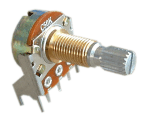
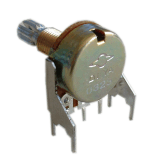
front view rear view Potentiometers used in the A-100
The A-100 potentiometers are available as spare parts with these values: 10K (A and B), 50K (A, B and C), 500k (B), 1M (A and B) with A = logarithmic (audio type), B = linear and C = inverse logarithmic (ususally for filter resonance controls used). For prices please look at theprice list. 

Trimming potentiometers are available normally only linear. Apart from that they are defined by the same parameters as normal potentiometers. ![]()
![]()
![]()
![]()


![]()

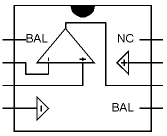
Single type 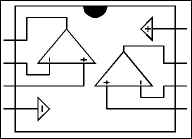
Dual type 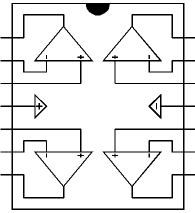
Quad type
Unused OpAmps (if e.g. only 3 devices of a quad opamp are used) have to be terminated in this way: non-inverting input has to be connected to GND, inverting input and output have to be connected (directly or even via resistor in the 1k...100k range). ![]()
![]()
![]()
![]()
![]()

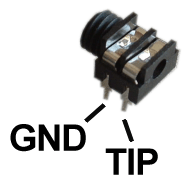
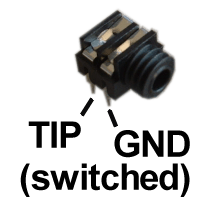
rear view front view jack sockets used in the A-100 ![]()
Electronics Now
-
This chip amplifier NCH TDA2030A company ST Microelectronics enjoys well-deserved popularity among radio amateurs. It has a high electric...
-
This paper presents a "Tube + integrated circuits" power amplifier, a voltage Larger bile tube, the former sub-frequency electroni...
-
The subwoofer is a subwoofer or a speaker to reproduce low frequencies, devotee of 20 Hz to 150 Hz electronic circuit diagram below shows th...
-
The valve itself, have a simple circuit enviable any transistor amplifier, however, not many projects that employ a single active component....
-
The famous SGS-THOMSON ST Microelectronics has introduced a Hi-Fi DMOS high-power amplifier circuit TDA7294, its sound great taste bile, whi...
Categories
The creator of THIS PAGE or the ISP(s) hosting any content on this site take NO responsibility for the way you use the information provided on this site. These circuits here are for educational purposes only and SHOULD BE VIEWED ONLY. If you download any files to view them, you are agreeing to delete them within a 24 hour period. If you are affiliated with any government, or ANTI-Piracy group or any other related group or were formally a worker of one you CANNOT enter this web site, cannot access any of its files and you cannot view any of the HTML files. All the objects on this site are PRIVATE property and are meant for previewing only. If you enter this site without following these agreements you are not agreeing to these terms and you are violating code 431.322.12 of the Internet Privacy Act signed by Bill Clinton in 1995 and that means that you CANNOT threaten our ISP(s) or any person(s) or company storing these files, cannot prosecute any person(s) affiliated with this page which includes family, friends or individuals who run or enter this web site. IF YOU DO NOT AGREE TO THESE TERMS THEN LEAVE.
All files are found using legitimate search engine techniques. This site does not and will not condone hacking into sites to create the links it list. We will and do assume that all links found on the search engines we use are obtained in a legal manner and the webmasters are aware of the links listed on the search engines. If you find a URL that belongs to you, and you did not realize that it was "open to the public", please use the report button to notify the blogmaster of your request to remove it. This is not an invitation for webblog haters to spam with requests to remove content they feel that is objectionable and or unacceptable. Proof of URL ownership is required.
NOTICE: This Blog Has Already Been Reviewed And Accepted By Blogger.com

This work is licensed under a Creative Commons Attribution-NonCommercial-NoDerivs 3.0 Unported License.
